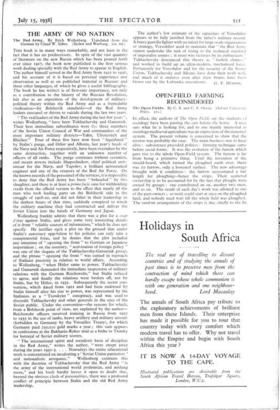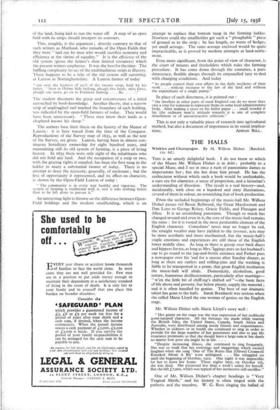OPEN-FIELD FARMING RECONSIDERED
The Open Fields. By C. S. and C. S. Orwin. (Oxford University Press. 21S.) IN effect, the authors of The Open Fields say the students ( f sociology have been putting the cart before the horse. A man sees what he is looking for, and to one mainly interested in sociology mediaeval agriculture was an expression of the manorial system. The present volume is concerned to show that the reverse was probably the case. The main business was to keep alive : subsistence preceded politics : farming technique came before social forms. It was the evolution of the furrow which gave rise to the whole Open-Field system. The furrow is far from being a primitive thing. Until the invention of the mould-board, which turned the ploughed earth over, there was no furrow, only a loosened surface. The new advantage brought with it conditions : the furrow necessitated a fair length for ploughing—hence the strips. Their scattered ownership is to be accounted for by the fact that ploughs were owned by groups : one contributed an ox, another two oxen, and so on. The result of each day's work was allotted to one of the part-owners ; so work could start at once on the ploughed land, and nobody need wait till the whole field was ploughed. The random arrangement of the strips is due chiefly to the lie
of the land, being laid to run the water off. A map of an open field with its strips should interpret its contours.
This, roughly, is the argument ; directly contrary to that of such writers as Maitland, who remarks of the Open Fields that they were " laid out by men who would sacrifice economy and efficiency at the shrine of equality." It is the efficiency of the old system (given the farmer's then limited resources) which the present writers emphasise. It was the best for the time. The baffling complexity (to us) of the multitudinous strips is illusory. There happens to be a relic of the old system still surviving, at Laxton in Nottinghamshire. A Laxton farmer of today " ran over the location of each of the twenty strips held by his father. ' Start in Holme Side furlong, plough two lands, miss three,
plough one more, go on to Foxmore furlong &c 3 33
The student discounts the grasp and retentiveness of a mind untouched by book-knowledge. Another theory, that a narrow strip of unploughed turf marked the boundary of each holding, was ridiculed by the open-field farmers of today. They would have been unnecessary. " These men know their lands as a shepherd knows his sheep."
The authors base their thesis on the history of the Manor of Laxton : it is here traced from the time of the Conquest. Reproductions of the Survey map of 1635, as well as the text of the Survey, are given. Laxton, having been in almost con- tinuous hereditary ownership for eight hundred years, and maintaining still its old system of farming, is a piece of living history. In 1635 there were only eight of the inhabitants who did not hold any land. And the occupation Of a strip or two, with the grazing rights it entailed, has been the first rung in the ladder to many a substantial farmer of today. There is no attempt to deny the necessity, generally, of enclosure ; but the loss of opportunity it represented, and its effect on character, is shown by the Open-Field Laxton of today : " The community is in every way healthy and vigorous. The system of farming is traditional with it, and it asks nothing better than to be left alone to pursue it."
An interesting light is thrown on the difference between Open- Field holdings and the modern smallholding, which is an
attempt to replace that bottom rung in the farming ladder. Nowhere could the smallholder get such a " ploughable " piece of ground as in the strip ; he has length, no waste of hedges, yet small acreage. The same acreage enclosed would be quite impracticable, as is proved by modern attempts at land-settle- ment.
Even more significant, from the point of view of character, is the court of tenants and freeholders which rules the farming procedure. It has come down through the centuries, a pure democracy, flexible always through its empanelled jury to deal with changing conditions.. And today
" its people control their own affairs in the daily incidents of their work . . . without recourse to the law of the land and without the expenditure of a single penny."
In place of such directness, it is pointed out : " the dwellers in other parts of rural England can do no more than cast a vote for someone to represent them on some local administrative body. After making a cross on his ballot paper . . . small wonder if his (the ordinary man's) attitude towards it is one of complete detachment or of unconstructive criticism."
This is not only a valuable piece of research into agricultural method, but also a document of importance in its social implica-











































 Previous page
Previous page